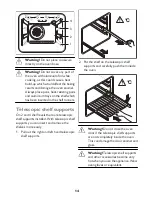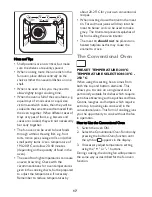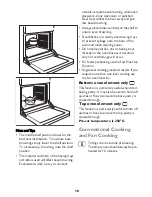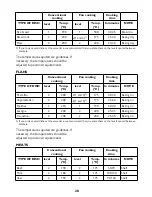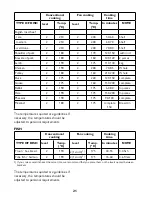
90°
7. Carefully lift and remove the panel of glass.
1
2
Clean the glass panel with water and soap.
Dry it carefully.
Warning!
Only clean the glass panel
with water and a soap. Abrasive
cleaning agents, stain removers and
sharp objects (e.g. knives or scrapers)
can cause damage to the glass.
Inserting the door and the glass
panel
When the cleaning procedure is completed,
insert the glass panel and the oven door. To
do so, do the steps in reverse.
The decorated internal panel marked with a
decorative frame must be assembled with the
screen-printing outside of the oven. The panel
of glass is assembled correctly if you do not
feel any roughness when you pass your fingers
over the surface.
Insert the internal panel of glass into the right
seats as on the picture.
Care of catalytic liners
Catalytic liners (except for the oven base)
destroy splashes of food and fats when the
oven temperature is raised to around 220°C.
To aid this process it is a good idea to run the
oven for an hour or two per week, without
food, to ensure continued good performance
from the Catalytic liners.
Hints and Tips
• Manual cleaning of the Catalytic liner is not
recommended. Damage will occur if soap
impregnated steel wool pads, aerosol
cleaners and any other abrasives are used.
• Slight discolouration and polishing of the
Catalytic surface may occur in time. This
does not affect the Catalytic properties in
any way.
• Follow the recommendations in Cooking
to reduce soilage
Cooking to reduce soilage
Cook at the recommended temperatures.
Higher temperatures during roasting will
increase soilage. Try cooking at lower
temperatures for an increased length of time,
you will save energy and often the joint is more
tender.
Use minimal, if any, extra oil or fat when
roasting meat; potatoes only require brushing
with fat before cooking. Extra fat in the oven
during roasting will increase splashing and
soilage. It is NOT necessary to add water to
28

